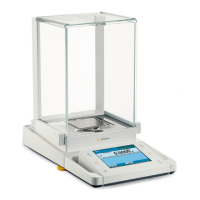Do you have a question about the Sartorius MSA3.6P and is the answer not in the manual?
Specific warning about using the equipment in hazardous areas with explosive materials.
Risks associated with static electricity, glass breakage, and chemical exposure.
Warnings related to electrical safety, voltage, and damaged components.
Detailed guide to leveling the balance using manual or motorized feet.
Options for defining calibration/adjustment functions and settings.
Setting parameters for timer-controlled actions, including repetition.
Information about the alibi memory for storing weighing results and process data.
Changing various equipment settings and updating software.
Detailed guide to leveling the balance using manual or motorized feet.
Configuring settings for printing and data output, depending on interface.
Setting up the Ethernet interface for network integration.
Setting up file formats and transfer options for printing to SD card or FTP server.
Specifying data transfer settings for connecting to an FTP server.
Configuring standard settings for general weighing functions.
Configuring serial ports and network settings for data exchange.
Defining settings for network operation, including device name and IP address.
Switching on, deleting data, and setting intervals for the alibi memory.
Selecting and determining settings for available serial interfaces.
A step-by-step example of creating a new task.
Defining basic and task-specific printout settings.
Modifying printout settings within the System Settings menu.
Rules and guidelines for combining multiple applications into a single task.
Steps to start and execute a configured task.
Creating new tasks by configuring various applications.
Steps to configure a custom weighing task.
How to start and run the configured "My Weighing" task.
Steps to configure a task for mass unit conversion.
How to start and run the configured mass unit conversion task.
Steps to configure the SQmin task, including function selection.
How to start and run the SQmin task, and interpret results.
How to start and run the task for individual identifiers.
Steps to configure density determination for solid samples using buoyancy or displacement.
Steps to configure density determination for liquid samples.
How to start and run the density determination task.
Steps to configure density determination for liquids using a pycnometer.
Steps to configure a task for statistical analysis of weight values.
How to start and run the statistics task for analyzing measurements.
Steps to configure a calculation task, using fixed or variable formulas.
How to execute the "Air buoyancy correction" calculation task.
How to execute the "Diameter determination" calculation task.
How to start and execute a general calculation task.
Steps to configure the averaging task, including start mode and min. load.
Configuring calculation factors and decimal places for averaging.
How to start and run the averaging task manually.
How to start and run the averaging task automatically.
How to start and run the formulation task, entering component details.
Steps to configure a formulation task, defining how weight values are applied.
Steps to configure a weighing in percent task, defining initiation and reference weight.
Selecting the type of percentage calculation (Rest, Loss, Ratio).
How to start and run the weighing in percent task, entering reference values.
Steps to configure timer-controlled functions, selecting mode and time input.
How to start and run timer-controlled functions.
Steps to configure the totalizing task, defining how weight values are applied.
How to start and run the totalizing task, entering item quantities.
Steps to configure the DKD measurement uncertainty display mode.
How to start and run the DKD measurement uncertainty task.
Steps to configure the second tare memory task.
How to start and run the second tare memory task.
Steps to configure the parts counting task, selecting the counting method.
How to perform parts counting after determining the average piece weight.
How to perform parts counting by manually entering the piece weight.
Steps to configure the checkweighing task, defining values and display modes.
Entering target and tolerance values for checkweighing.
Using the current load to define check values.
Selecting data to export and configuring export folder settings.
Selecting data from an SD card to import into the balance.
Steps for performing calibration using an internal check weight.
Steps for performing calibration using an external check weight.
Overview of user administration, defining administrators and users with distinct rights.
Selecting whether a user profile should be password-protected.
How to activate different user profiles on the balance.
Modifying existing user profiles, including changing names and passwords.
Function available only to administrators for creating new user profiles.
Entering and confirming a password for the user profile.
Connecting the balance to a PC via USB, including system requirements and driver installation.
Connecting and using PS2 devices like bar code scanners or keyboards.
Details on RS-232 interfaces, pin assignments, and connectable peripherals.
Determining settings for available serial interfaces.
Settings for printer output, including printer types and protocols.
Configuring the Bluetooth interface for data output.
Integrating the balance into a TCP/IP-based network via Ethernet.
Setting up network operation, including DHCP and IP address configuration.
Defining operating mode and connection type for the network interface.
Defining data output parameters activated by print command or automatically.
Setting up the balance for Bluetooth printer output.
Steps to download the software update file to a computer.
Steps to upload the software update from the SD card to the balance.
Specific warning about using the equipment in hazardous areas with explosive materials.
Risks associated with static electricity, glass breakage, and chemical exposure.
Warnings related to electrical safety, voltage, and damaged components.
Detailed guide to leveling the balance using manual or motorized feet.
Options for defining calibration/adjustment functions and settings.
Setting parameters for timer-controlled actions, including repetition.
Information about the alibi memory for storing weighing results and process data.
Changing various equipment settings and updating software.
Detailed guide to leveling the balance using manual or motorized feet.
Configuring settings for printing and data output, depending on interface.
Setting up the Ethernet interface for network integration.
Setting up file formats and transfer options for printing to SD card or FTP server.
Specifying data transfer settings for connecting to an FTP server.
Configuring standard settings for general weighing functions.
Configuring serial ports and network settings for data exchange.
Defining settings for network operation, including device name and IP address.
Switching on, deleting data, and setting intervals for the alibi memory.
Selecting and determining settings for available serial interfaces.
A step-by-step example of creating a new task.
Defining basic and task-specific printout settings.
Modifying printout settings within the System Settings menu.
Rules and guidelines for combining multiple applications into a single task.
Steps to start and execute a configured task.
Creating new tasks by configuring various applications.
Steps to configure a custom weighing task.
How to start and run the configured "My Weighing" task.
Steps to configure a task for mass unit conversion.
How to start and run the configured mass unit conversion task.
Steps to configure the SQmin task, including function selection.
How to start and run the SQmin task, and interpret results.
How to start and run the task for individual identifiers.
Steps to configure density determination for solid samples using buoyancy or displacement.
Steps to configure density determination for liquid samples.
How to start and run the density determination task.
Steps to configure density determination for liquids using a pycnometer.
Steps to configure a task for statistical analysis of weight values.
How to start and run the statistics task for analyzing measurements.
Steps to configure a calculation task, using fixed or variable formulas.
How to execute the "Air buoyancy correction" calculation task.
How to execute the "Diameter determination" calculation task.
How to start and execute a general calculation task.
Steps to configure the averaging task, including start mode and min. load.
Configuring calculation factors and decimal places for averaging.
How to start and run the averaging task manually.
How to start and run the averaging task automatically.
How to start and run the formulation task, entering component details.
Steps to configure a formulation task, defining how weight values are applied.
Steps to configure a weighing in percent task, defining initiation and reference weight.
Selecting the type of percentage calculation (Rest, Loss, Ratio).
How to start and run the weighing in percent task, entering reference values.
Steps to configure timer-controlled functions, selecting mode and time input.
How to start and run timer-controlled functions.
Steps to configure the totalizing task, defining how weight values are applied.
How to start and run the totalizing task, entering item quantities.
Steps to configure the DKD measurement uncertainty display mode.
How to start and run the DKD measurement uncertainty task.
Steps to configure the second tare memory task.
How to start and run the second tare memory task.
Steps to configure the parts counting task, selecting the counting method.
How to perform parts counting after determining the average piece weight.
How to perform parts counting by manually entering the piece weight.
Steps to configure the checkweighing task, defining values and display modes.
Entering target and tolerance values for checkweighing.
Using the current load to define check values.
Selecting data to export and configuring export folder settings.
Selecting data from an SD card to import into the balance.
Steps for performing calibration using an internal check weight.
Steps for performing calibration using an external check weight.
Overview of user administration, defining administrators and users with distinct rights.
Selecting whether a user profile should be password-protected.
How to activate different user profiles on the balance.
Modifying existing user profiles, including changing names and passwords.
Function available only to administrators for creating new user profiles.
Entering and confirming a password for the user profile.
Connecting the balance to a PC via USB, including system requirements and driver installation.
Connecting and using PS2 devices like bar code scanners or keyboards.
Details on RS-232 interfaces, pin assignments, and connectable peripherals.
Determining settings for available serial interfaces.
Settings for printer output, including printer types and protocols.
Configuring the Bluetooth interface for data output.
Integrating the balance into a TCP/IP-based network via Ethernet.
Setting up network operation, including DHCP and IP address configuration.
Defining operating mode and connection type for the network interface.
Defining data output parameters activated by print command or automatically.
Setting up the balance for Bluetooth printer output.
Steps to download the software update file to a computer.
Steps to upload the software update from the SD card to the balance.
| Maximum Capacity | 3.6 g |
|---|---|
| Readability | 0.1 µg |
| Pan Size | Ø 20 mm |
| Display Type | LCD |
| Dimensions | 243 x 390 x 350 mm |
| Interface | RS232 |
| Power Supply | AC adapter |
| Calibration | Internal calibration |
| Operating Humidity | 15 % to 80 % |











